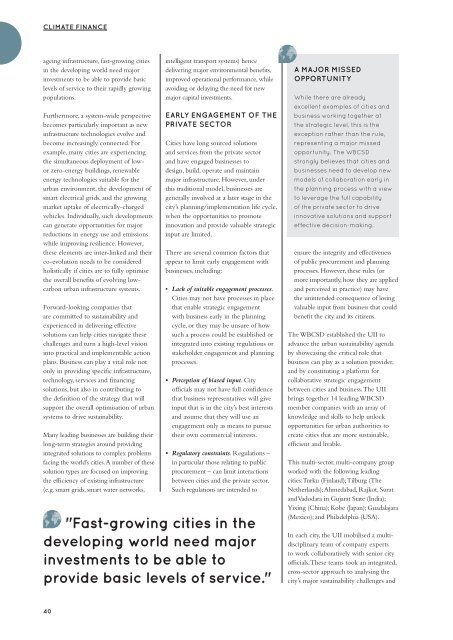Climate Action 2014-2015
Create successful ePaper yourself
Turn your PDF publications into a flip-book with our unique Google optimized e-Paper software.
CLIMATE FINANCE<br />
ageing infrastructure, fast-growing cities<br />
in the developing world need major<br />
investments to be able to provide basic<br />
levels of service to their rapidly growing<br />
populations.<br />
Furthermore, a system-wide perspective<br />
becomes particularly important as new<br />
infrastructure technologies evolve and<br />
become increasingly connected. For<br />
example, many cities are experiencing<br />
the simultaneous deployment of lowor<br />
zero-energy buildings, renewable<br />
energy technologies suitable for the<br />
urban environment, the development of<br />
smart electrical grids, and the growing<br />
market uptake of electrically-charged<br />
vehicles. Individually, such developments<br />
can generate opportunities for major<br />
reductions in energy use and emissions<br />
while improving resilience. However,<br />
these elements are inter-linked and their<br />
co-evolution needs to be considered<br />
holistically if cities are to fully optimise<br />
the overall benefits of evolving lowcarbon<br />
urban infrastructure systems.<br />
Forward-looking companies that<br />
are committed to sustainability and<br />
experienced in delivering effective<br />
solutions can help cities navigate these<br />
challenges and turn a high-level vision<br />
into practical and implementable action<br />
plans. Business can play a vital role not<br />
only in providing specific infrastructure,<br />
technology, services and financing<br />
solutions, but also in contributing to<br />
the definition of the strategy that will<br />
support the overall optimisation of urban<br />
systems to drive sustainability.<br />
Many leading businesses are building their<br />
long-term strategies around providing<br />
integrated solutions to complex problems<br />
facing the world’s cities. A number of these<br />
solution types are focused on improving<br />
the efficiency of existing infrastructure<br />
(e.g. smart grids, smart water networks,<br />
intelligent transport systems) hence<br />
delivering major environmental benefits,<br />
improved operational performance, while<br />
avoiding or delaying the need for new<br />
major capital investments.<br />
EARLY ENGAGEMENT OF THE<br />
PRIVATE SECTOR<br />
Cities have long sourced solutions<br />
and services from the private sector<br />
and have engaged businesses to<br />
design, build, operate and maintain<br />
major infrastructure. However, under<br />
this traditional model, businesses are<br />
generally involved at a later stage in the<br />
city’s planning/implementation life cycle,<br />
when the opportunities to promote<br />
innovation and provide valuable strategic<br />
input are limited.<br />
There are several common factors that<br />
appear to limit early engagement with<br />
businesses, including:<br />
Lack of suitable engagement processes.<br />
Cities may not have processes in place<br />
that enable strategic engagement<br />
with business early in the planning<br />
cycle, or they may be unsure of how<br />
such a process could be established or<br />
integrated into existing regulations or<br />
stakeholder engagement and planning<br />
processes.<br />
Perception of biased input. City<br />
officials may not have full confidence<br />
that business representatives will give<br />
input that is in the city’s best interests<br />
and assume that they will use an<br />
engagement only as means to pursue<br />
their own commercial interests.<br />
Regulatory constraints. Regulations –<br />
in particular those relating to public<br />
procurement – can limit interactions<br />
between cities and the private sector.<br />
Such regulations are intended to<br />
"Fast-growing cities in the<br />
developing world need major<br />
investments to be able to<br />
provide basic levels of service."<br />
A MAJOR MISSED<br />
OPPORTUNITY<br />
While there are already<br />
excellent examples of cities and<br />
business working together at<br />
the strategic level, this is the<br />
exception rather than the rule,<br />
representing a major missed<br />
opportunity. The WBCSD<br />
strongly believes that cities and<br />
businesses need to develop new<br />
models of collaboration early in<br />
the planning process with a view<br />
to leverage the full capability<br />
of the private sector to drive<br />
innovative solutions and support<br />
effective decision-making.<br />
ensure the integrity and effectiveness<br />
of public procurement and planning<br />
processes. However, these rules (or<br />
more importantly, how they are applied<br />
and perceived in practice) may have<br />
the unintended consequence of losing<br />
valuable input from business that could<br />
benefit the city and its citizens.<br />
The WBCSD established the UII to<br />
advance the urban sustainability agenda<br />
by showcasing the critical role that<br />
business can play as a solution provider,<br />
and by constituting a platform for<br />
collaborative strategic engagement<br />
between cities and business. The UII<br />
brings together 14 leading WBCSD<br />
member companies with an array of<br />
knowledge and skills to help unlock<br />
opportunities for urban authorities to<br />
create cities that are more sustainable,<br />
efficient and livable.<br />
This multi-sector, multi-company group<br />
worked with the following leading<br />
cities: Turku (Finland); Tilburg (The<br />
Netherlands); Ahmedabad, Rajkot, Surat<br />
and Vadodara in Gujarat State (India);<br />
Yixing (China); Kobe (Japan); Guadalajara<br />
(Mexico); and Philadelphia (USA).<br />
In each city, the UII mobilised a multidisciplinary<br />
team of company experts<br />
to work collaboratively with senior city<br />
officials. These teams took an integrated,<br />
cross-sector approach to analysing the<br />
city’s major sustainability challenges and<br />
40












